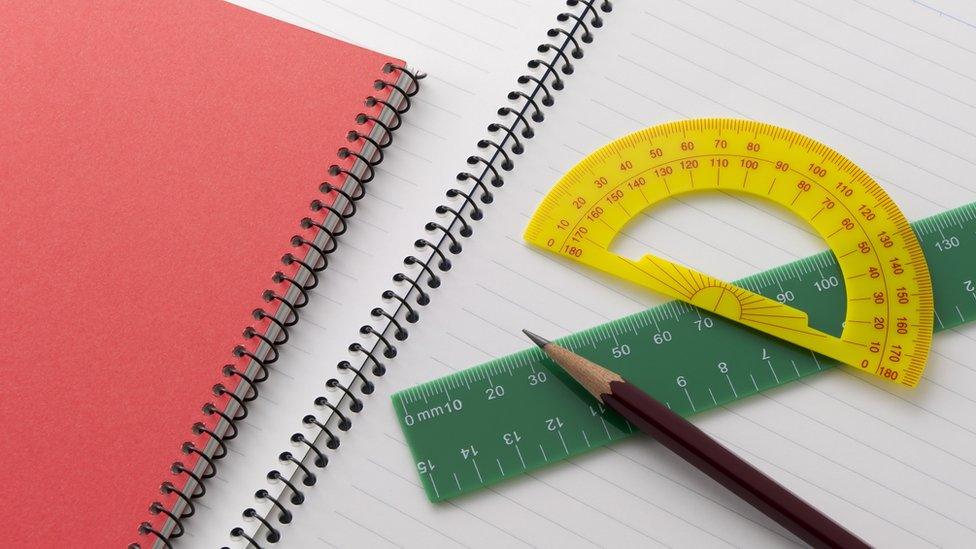School league table data explained
- Published

The BBC News website looks at key questions about the publication of school performance data in England.
What is school performance data?
School performance data is statistical information showing how well pupils in England have done in public examinations taken at key points in their educational journey.
Data is published for children's attainment in national curriculum tests, often known as Sats, which are taken at the end of primary school at age 10 or 11.
At secondary school level, data is published detailing pupils' performance in GCSEs (and equivalent exams) at age 16 and A-levels (and equivalents) at age 18.
Haven't the primary Sats exams changed?
Yes. The cohort of pupils who sat national curriculum tests, known as Sats, in the summer term of 2016 were the first to sit more rigorous papers.
Until 2015, Sats tests were graded on levels - for example Level 4 was the expected level for children finishing primary school, but these levels have now been scrapped.
Instead, parents are given their child's raw scores (the marks they get) and whether or not they have reached the expected level.
The reading and maths test scores are given on a scale of 80 to 120 - with a score of 100 or more meaning a pupil is meeting the expected standard.
For writing - which is teacher assessed - meeting the expected standard means the pupil was considered to be on target or working at a greater depth.

League tables are based on public exams taken at Key Stage 4 and 5
What is considered to be acceptable performance for primary schools?
This year, a primary school will meet the government's floor target if:
at least 65% of pupils meet the expected standard in English reading, English writing and mathematics; or
the school achieves sufficient progress scores in all three subjects.
To be above the floor, the school needs to meet either the attainment or all of the progress element.
In previous years, schools had to get 65% of pupils to a Level 4 (under the old measure) in maths, reading and writing and see pupils make the expected progress.
Aren't secondary school tables changing this year?
Yes. From this year, schools in England will be measured on what is known as Progress 8, external.
Progress 8 will replace the old measure - five or more good GCSEs, including maths and English - as the benchmark for all secondary schools.
Progress 8 assesses the progress pupils make between Key Stage 2 tests taken at the end of primary school and their performance in a specified mixture of eight subjects at the end of secondary school. Schools will be given a score based on how their pupils have progressed compared with the national average.
The data will be published in January.

How is the performance data presented?
The Department for Education publishes the data, with a facility on its website that allows users to rank schools in England by different measures.
Some media organisations use the data to produce rankings as well.
What happens in the rest of the UK?
Wales and Northern Ireland abolished the publication of school league tables in 2001, followed by Scotland in 2003.
This year however, data about how well Scottish pupils do in reading, writing and numeracy has been published for the first time, as part of the new Curriculum for Excellence.
Wales has also recently reintroduced the publication of performance information.
In January, the Welsh Assembly started grading schools in a colour code - green, yellow, amber or red - in a bid to raise standards.
What are the arguments for presenting performance data in this way?
The performance data in league tables is used widely by parents to judge how well schools in their area perform.
Supporters argue that the tables help drive up standards by increasing the accountability of schools and providing valuable information for parents.
Research carried out by Bristol University suggested the abolition of league tables in Wales in 2001 had led to a drop in standards in the lowest 75% of schools.

What are the arguments against the publication of this information?
Opponents say comparing schools in this way is too crude a measure of a school's quality, achievements and character.
They argue that the tables often say more about the intake of a school than the teaching and learning that goes on there.
Critics also say the tables encourage competition, rather than collaboration, between schools in local areas and can lead to middle-class parents pushing to get their children into top schools, further driving down standards at less popular schools.
There are also suggestions that children are pushed into subjects and choices that make the school look good, rather than broadening their education.
Should I choose a school for my child based on league tables?
The tables show how well a particular year group of pupils at a given school has performed in tests or exams.
The tables do not include information about the more holistic elements of a school such as extra-curricular activities on offer - for example, sport and drama - or details about a school's pastoral care system. Some of these details may feature in the school's Ofsted report.
It is always advisable to visit a school - most schools run open days or evenings for prospective pupils and parents.
- Published15 December 2016
